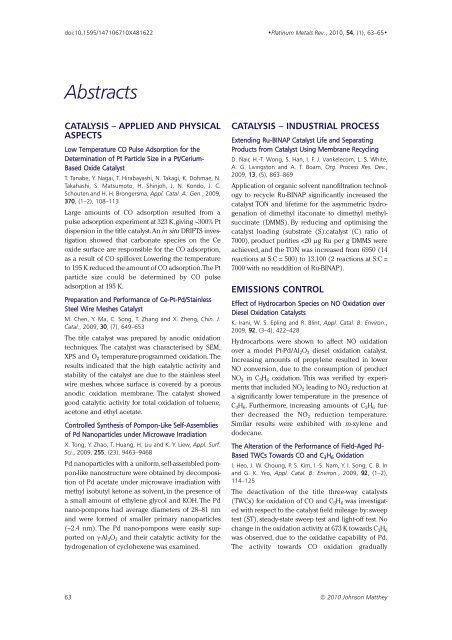Download Issue PDF - Platinum Metals Review
Download Issue PDF - Platinum Metals Review
Download Issue PDF - Platinum Metals Review
Create successful ePaper yourself
Turn your PDF publications into a flip-book with our unique Google optimized e-Paper software.
doi:10.1595/147106710X481622<br />
•<strong>Platinum</strong> <strong>Metals</strong> Rev., 2010, 54, (1), 63–65•<br />
Abstracts<br />
CATALYSIS – APPLIED AND PHYSICAL<br />
ASPECTS<br />
Low Temperature CO Pulse Adsorption for the<br />
Determination of Pt Particle Size in a Pt/Cerium-<br />
Based Oxide Catalyst<br />
T. Tanabe, Y. Nagai, T. Hirabayashi, N. Takagi, K. Dohmae, N.<br />
Takahashi, S. Matsumoto, H. Shinjoh, J. N. Kondo, J. C.<br />
Schouten and H. H. Brongersma, Appl. Catal. A: Gen., 2009,<br />
370, (1–2), 108–113<br />
Large amounts of CO adsorption resulted from a<br />
pulse adsorption experiment at 323 K,giving ~300% Pt<br />
dispersion in the title catalyst.An in situ DRIFTS investigation<br />
showed that carbonate species on the Ce<br />
oxide surface are responsible for the CO adsorption,<br />
as a result of CO spillover. Lowering the temperature<br />
to 195 K reduced the amount of CO adsorption.The Pt<br />
particle size could be determined by CO pulse<br />
adsorption at 195 K.<br />
Preparation and Performance of Ce-Pt-Pd/Stainless<br />
Steel Wire Meshes Catalyst<br />
M. Chen, Y. Ma, C. Song, T. Zhang and X. Zheng, Chin. J.<br />
Catal., 2009, 30, (7), 649–653<br />
The title catalyst was prepared by anodic oxidation<br />
techniques. The catalyst was characterised by SEM,<br />
XPS and O 2 temperature-programmed oxidation. The<br />
results indicated that the high catalytic activity and<br />
stability of the catalyst are due to the stainless steel<br />
wire meshes, whose surface is covered by a porous<br />
anodic oxidation membrane. The catalyst showed<br />
good catalytic activity for total oxidation of toluene,<br />
acetone and ethyl acetate.<br />
Controlled Synthesis of Pompon-Like Self-Assemblies<br />
of Pd Nanoparticles under Microwave Irradiation<br />
X. Tong, Y. Zhao, T. Huang, H. Liu and K. Y. Liew, Appl. Surf.<br />
Sci., 2009, 255, (23), 9463–9468<br />
Pd nanoparticles with a uniform,self-assembled pompon-like<br />
nanostructure were obtained by decomposition<br />
of Pd acetate under microwave irradiation with<br />
methyl isobutyl ketone as solvent, in the presence of<br />
a small amount of ethylene glycol and KOH. The Pd<br />
nano-pompons had average diameters of 28–81 nm<br />
and were formed of smaller primary nanoparticles<br />
(~2.4 nm). The Pd nano-pompons were easily supported<br />
on γ-Al 2 O 3 and their catalytic activity for the<br />
hydrogenation of cyclohexene was examined.<br />
CATALYSIS – INDUSTRIAL PROCESS<br />
Extending Ru-BINAP Catalyst Life and Separating<br />
Products from Catalyst Using Membrane Recycling<br />
D. Nair, H.-T. Wong, S. Han, I. F. J. Vankelecom, L. S. White,<br />
A. G. Livingston and A. T. Boam, Org. Process Res. Dev.,<br />
2009, 13, (5), 863–869<br />
Application of organic solvent nanofiltration technology<br />
to recycle Ru-BINAP significantly increased the<br />
catalyst TON and lifetime for the asymmetric hydrogenation<br />
of dimethyl itaconate to dimethyl methylsuccinate<br />
(DMMS). By reducing and optimising the<br />
catalyst loading (substrate (S):catalyst (C) ratio of<br />
7000), product purities
















